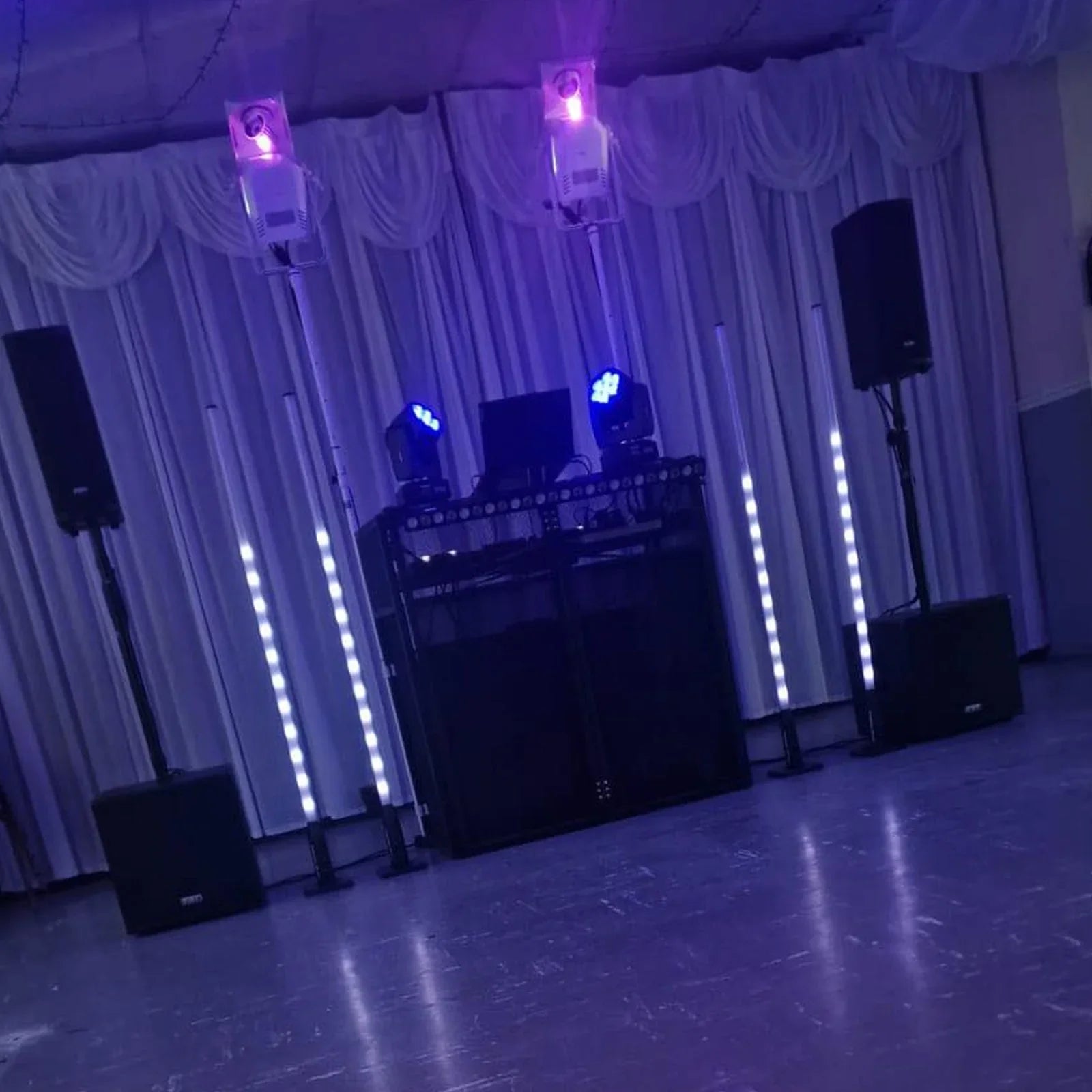When you think of a DJ performance, what comes to mind? Great music, of course! But equally important is the lighting—it sets the mood, energizes the crowd, and turns a good set into an unforgettable experience. Whether you're a beginner DJ or a seasoned professional, creating a balanced DJ lighting rig is essential to achieving the perfect atmosphere for any event.
In this post, we’ll walk you through the key components of a DJ lighting rig, the importance of balance, and how to get the most out of your lights to enhance your performance.
Why a Balanced Lighting Rig Matters 🎧✨
A well-balanced DJ lighting rig is the perfect mix of functionality and aesthetics. It involves using a variety of lighting tools to create dynamic visual effects that match the energy of your music. But a truly balanced rig doesn’t just rely on a single type of light; instead, it incorporates different types of lights, each fulfilling a specific role.
Here are a few reasons why balance matters:
-
Even Coverage: A balanced rig ensures that all areas of the event space are evenly lit without overexposing any one area.
-
Dynamic Visuals: Mixing different light types creates a dynamic, evolving atmosphere that keeps the crowd engaged.
-
Cohesive Design: The right combination of moving heads, par cans, LED bars, and other lights ensures a cohesive visual experience that complements your music.
Now that we know why balance is important, let’s dive into how you can achieve it!
Key Components of a Balanced DJ Lighting Rig 🛠️
Creating a balanced lighting rig requires a strategic combination of lighting fixtures, each serving a unique purpose in your setup. Below are the most common types of lights to include in your rig.
1. Par Cans (For General Illumination) 💡
Par cans (parabolic aluminized reflector) are the workhorses of any DJ lighting rig. These lights provide general wash lighting and can be used to illuminate large areas with solid colors or create smooth color transitions.
-
Positioning: Place par cans around the stage or dance floor to provide even, base-level lighting. If you have a larger space, consider mounting them on lighting stands or trusses.
-
Colors: Use RGB par cans to create vibrant, dynamic colors that change with the beat.
2. Moving Heads (For Dynamic Effects) 🔄
Moving heads are one of the most versatile lighting tools in any DJ’s arsenal. These lights are designed to move and pan to create complex patterns and dramatic effects. Moving heads are typically equipped with RGB LEDs, gobo projectors, and a zoom feature, making them perfect for adding flair to your rig.
-
Positioning: Mount moving heads above the crowd on trusses or overhead mounts to create sweeping light beams. Place them at different angles to give your rig depth.
-
Functionality: Use them for beam effects, gobo patterns, and spotlighting. Set them to change in time with the beat for maximum visual impact.
3. LED Bars (For Color Wash and Effects) 🌈
LED bars are perfect for creating color washes or adding background effects that don’t overpower the main lighting. They can be placed along the floor or on a backdrop to project smooth light across large areas.
-
Positioning: Place LED bars at the front of the stage, along the back of the booth, or on the ground to illuminate the dance floor.
-
Functionality: These lights are fantastic for creating vibrant, sweeping color transitions or filling in gaps between moving heads.
4. Strobe Lights (For High-Energy Moments) ⚡
Strobe lights can create fast, high-intensity flashes that emphasize certain moments in the music—like during the drop or a major build-up. These lights add a sense of drama and urgency, which is why they're often used during intense moments of a DJ set.
-
Positioning: Use strobe lights sparingly and only for specific moments. Too much strobe can be disorienting. Place them on the sides or top of your rig to provide accent lighting.
-
Timing: Sync the strobes with the music’s beat to intensify the impact during high-energy drops.
5. Lasers (For Cool Effects and Precision) 🌟
Laser lights are ideal for creating sharp, focused beams that can cut through fog or haze. They’re perfect for creating geometric patterns, beam effects, and adding an extra layer of excitement to your lighting rig.
-
Positioning: Mount lasers at the back of the stage to create long, sweeping beams of light. Alternatively, position them at various angles to create a unique pattern across the room.
-
Functionality: Use lasers in conjunction with fog or haze machines to create stunning, 3D beam effects.
Balancing Your Lighting Rig: Tips for Perfect Setup ⚖️
Now that we’ve covered the key components, it’s time to look at how to balance them. An unbalanced rig can either be too dim, too harsh, or chaotic, which can take away from the experience. Here are a few tips to keep your lighting rig in check:
1. Balance Your Color Palette 🌈
-
Don’t overwhelm your crowd with too many colors at once. Use a primary color for your wash (usually blue, red, or purple) and complement it with accent colors from your moving heads or LED bars.
-
For example, if your moving heads are creating gobo patterns, use warm white or amber for your par cans to ensure the whole rig doesn’t become too saturated with color.
2. Mix Static and Moving Lights 🔄
-
Static lights like par cans can cover a wide area, providing base-level illumination, while moving heads add dynamism and excitement. Aim to balance both so the stage doesn’t feel too static or too chaotic.
-
For example, use par cans for broad coverage and color washes, and then add moving heads for accent lighting, beams, and patterns that move with the rhythm.
3. Height and Angle Matter ⬆️
-
Vary the height and angles of your lights to create depth and dimension. For example, position moving heads higher up for sweeping effects, while par cans can be closer to the ground for base-level lighting.
-
Experiment with different heights, mounting your lights on trusses or hanging them from the ceiling for greater visual interest.
4. Use Fog or Haze to Enhance Effects 🌫️
-
Fog and haze can help your lights “cut through” the air, creating a more dramatic effect. When paired with lasers or moving heads, fog creates beautiful beams that show the movement of the light.
-
Ensure that you use fog or haze sparingly to avoid overpowering the space. It should complement your lights, not block them out.
5. Don’t Forget the Crowd! 🎤
-
Make sure that your lighting is evenly distributed around the stage, dance floor, and crowd. Spotlights on the DJ booth, combined with a mix of ambient lighting for the audience, will create a more immersive experience for everyone.
Conclusion: Creating the Ultimate DJ Lighting Rig 🎧🌟
A balanced DJ lighting rig involves combining a variety of lighting tools to achieve a dynamic, engaging atmosphere. By using the right mix of par cans, moving heads, LED bars, strobes, and lasers, you can create a show that complements your music and keeps the crowd energized all night long.
Remember to focus on color balance, timing, and proper placement to ensure your lights create a cohesive and exciting visual experience. With the right lighting, your DJ performance will shine brighter than ever, leaving your audience with an unforgettable experience.

